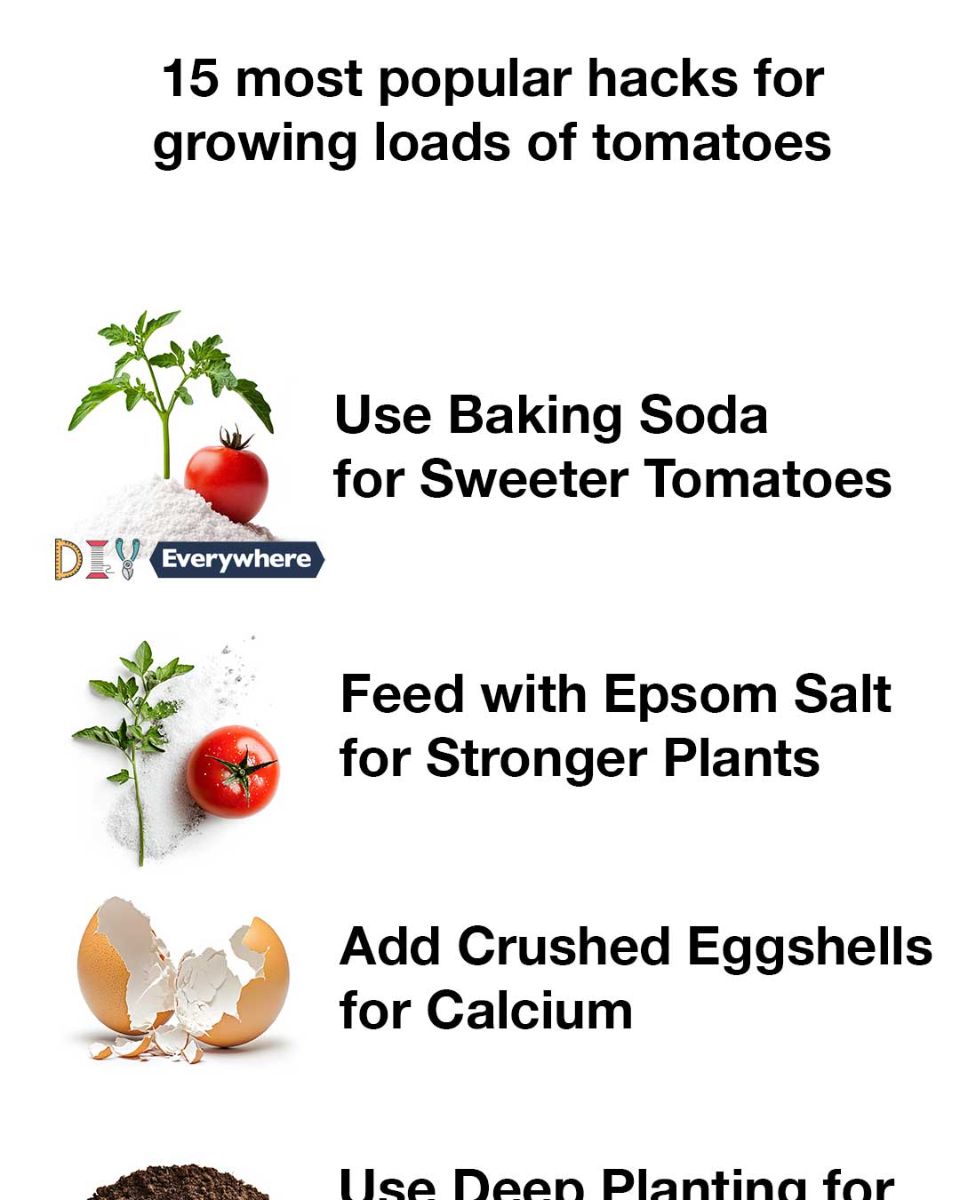Nothing beats the taste of homegrown tomatoes—juicy, sun-ripened, and bursting with flavor. Whether you’re slicing them for sandwiches, tossing them into salads, or simmering them into sauces, tomatoes are a garden favorite for a reason. But getting a bountiful harvest isn’t always as simple as planting and watering. Tomatoes are heavy feeders with specific needs, and a few clever gardening hacks can make a world of difference in both yield and quality.
From pantry staples like baking soda and Epsom salt to time-tested companion planting with marigolds, there are plenty of easy, natural ways to boost your tomato game. In this guide, we’ve rounded up the 15 most popular and effective tips to help you grow stronger plants, deter pests, and produce sweeter, more flavorful tomatoes. Whether you’re a seasoned green thumb or a first-time grower, these techniques will set you up for your most abundant tomato harvest yet.
Advertisement
1. Use Baking Soda for Sweeter Tomatoes
Sprinkling a small amount of baking soda around the base of your tomato plants can reduce soil acidity, resulting in sweeter fruit. Use about 1 tablespoon per plant, applying it gently to the soil every 2–3 weeks. Be careful not to get it on the leaves or stems.
2. Feed with Epsom Salt for Stronger Plants
Tomatoes love magnesium, and Epsom salt is a rich source. It helps boost photosynthesis and fruit development. Mix 1 tablespoon of Epsom salt with 1 gallon of water and water the base of your plants every 2–4 weeks. You can also sprinkle a tablespoon into the planting hole.
3. Plant Marigolds Beneath Your Tomatoes
Marigolds are natural pest repellents. They deter aphids, whiteflies, and nematodes while attracting beneficial insects. Plant a few marigold seeds or transplants directly under and around each tomato plant. They’ll thrive in the same sunny conditions.
Marigolds are natural pest repellents. They deter aphids, whiteflies, and nematodes while attracting beneficial insects. Plant a few marigold seeds or transplants directly under and around each tomato plant. They’ll thrive in the same sunny conditions.
4. Add Crushed Eggshells for Calcium
Blossom end rot (those dark, sunken spots on the bottom of tomatoes) is caused by calcium deficiency. Crushed eggshells provide a slow-release source. Add 4–5 crushed eggshells to the planting hole or scatter them around the base of established plants.
Blossom end rot (those dark, sunken spots on the bottom of tomatoes) is caused by calcium deficiency. Crushed eggshells provide a slow-release source. Add 4–5 crushed eggshells to the planting hole or scatter them around the base of established plants.
5. Use Deep Planting for Stronger Roots
When transplanting seedlings, bury them deep—up to the first or second set of leaves. Tomatoes can grow roots all along their buried stems, creating a stronger, more stable root system.
6. Mulch with Straw or Grass Clippings
Tomatoes love even soil moisture. Mulching helps retain water, prevent weeds, and regulate temperature. Use 2–3 inches of straw, dried grass clippings, or shredded leaves around the base of each plant, leaving a small gap around the stem.
7. Pinch Off Suckers for Bigger Fruit
Suckers are small shoots that grow between the main stem and branches. While they don’t harm the plant, they take energy away from fruit production. Pinch them off when they’re 2–4 inches long to focus the plant’s energy on producing fewer but larger tomatoes.
8. Water Deeply and Consistently
Tomatoes need consistent moisture to avoid cracking and blossom end rot. Water deeply 1–2 inches per week, preferably early in the morning. Drip irrigation or soaker hoses work best to keep leaves dry and prevent disease.
9. Add Compost or Aged Manure
Tomatoes are heavy feeders. Adding 2–3 inches of compost or well-rotted manure to the planting hole or as a top dressing every few weeks keeps plants nutrient-rich and productive.
10. Use Tomato Cages or Sturdy Stakes
Support prevents sprawling and keeps fruits off the ground. Use tomato cages or 6–8 foot stakes, tying the plant loosely with soft twine as it grows. Proper airflow around plants also reduces fungal disease.
11. Rotate Crops Every Year
Avoid planting tomatoes (or other nightshades like peppers or eggplants) in the same spot each year. Rotate to a different area to reduce the risk of soil-borne diseases and nutrient depletion.
12. Fertilize with a Balanced Tomato Fertilizer
Use a fertilizer formulated for tomatoes, typically lower in nitrogen and higher in phosphorus and potassium (like 5-10-10 or 10-20-20). Apply according to package instructions every 2–4 weeks for optimal growth and fruiting.
13. Use Companion Plants Like Basil and Garlic
In addition to marigolds, basil repels pests and may improve tomato flavor, while garlic deters red spider mites. Plant basil nearby or interplant garlic cloves around the tomato bed.
14. Prune the Lower Leaves
As the tomato plant grows, remove the bottom 6–12 inches of leaves. These are the most susceptible to soil-borne diseases and poor air circulation. Pruning keeps the plant healthy and reduces disease risk.
15. Harvest Frequently to Encourage More Fruit
Tomato plants respond to harvest by producing more. Pick ripe fruit every couple of days to keep the plant focused on fruiting rather than just maintaining existing tomatoes.
Advertisement
Conclusion: Enjoying the Fruits of Your Labor
With these 15 tips, you'll be well on your way to growing a bountiful crop of tomatoes. Whether you enjoy them fresh, in sauces, or preserved for later use, the satisfaction of growing your own tomatoes is unmatched. By understanding the needs of your plants and providing them with the right care, you can enjoy the delicious fruits of your labor all season long.

